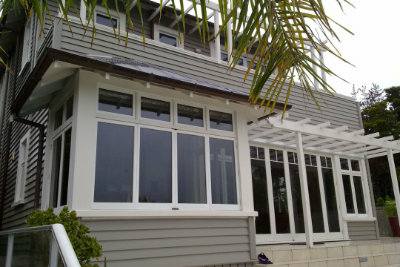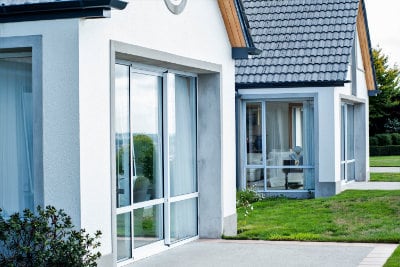Double Glazing Explained
Double Glazing Explained
What about glass coatings (“low e” glass)?
Low emissivity (low e) glass contains a special coating of tiny particles on the surface of the glass that reflect heat energy. This coating reduces the amount of heat that can be transferred through the glass, improving its thermal properties.
Low E glass coatings work by reflecting or absorbing IR light (heat energy). The type and thickness of the Low E coating and the position in the double glazing unit (#2 or #3 surface) dictate how the window will perform.
Traditional low e glass is made ‘online’ on the glass float line. The particles on the glass are tiny, but under certain light conditions can be visible as a haze, or ‘purple doppled effect’. With technological improvements in manufacturing low e glass, the process has moved ‘offline’. The particles are much, much smaller – to the point that products such as SuperTherm are nanoscopic (moving to the atomic level). Applied right, they have no visual haze at all (an important distinction in comparing the type of low e glass being installed in your home).
In New Zealand, low e glass has traditionally been positioned on the #3 surface of a double glazing unit. Here, the low e coating is designed to reflect infrared (IR) heat from inside the room to help reduce the energy loss during the cold months, thereby reducing heating costs. Advanced low e glass, such as SuperTherm Warm™ has been specially designed to let a large amount of the Sun’s warmth into your home and to keep the warmth in.
When installed on the #2 surface of a double glazing unit, improved versions of low e glass reflect solar heat (including IR) from the outside, thereby reducing solar gain and cooling costs during the warm months. Advanced low e glass, such as SuperTherm Cool™ has been specially designed to reflect away more solar heat than alternatives. In fact, in the case of SuperTherm Cool™, it performs better than traditional grey tint and lets substantially more light in.
While in the past low e coatings have been used on single glass (including the use of some low e films), the high-performance coatings used today are sealed inside double glazing. These low e glass solutions provide far superior thermal insulation to the single glazed alternatives.
Low e coatings on single glass provide a thermal performance improvement of about 38%. In comparison, standard double glazing (12mm space, air-filled), has a thermal performance improvement of 54%.
When advanced SuperTherm™ low e lass is used in double glazing it can have a thermal performance improvement of up to 83%. Remarkable!
Choose SuperTherm™ double glazing with argon gas fill for superior thermal performance.

Whatever your double glazing needs are, you can be confident that we will provide the right retroGLAZE solution for your home
Explore our retroGLAZE® solutions
Timber Retrofit
Retain the character & superior insulating properties of timber, upgraded with high performing double glazing.
Aluminium Retrofit
Upgrade your existing single glazed aluminium windows & doors to high performing double glazing.
Replacement Windows
Refresh and modernise your home with new high performance windows and doors



